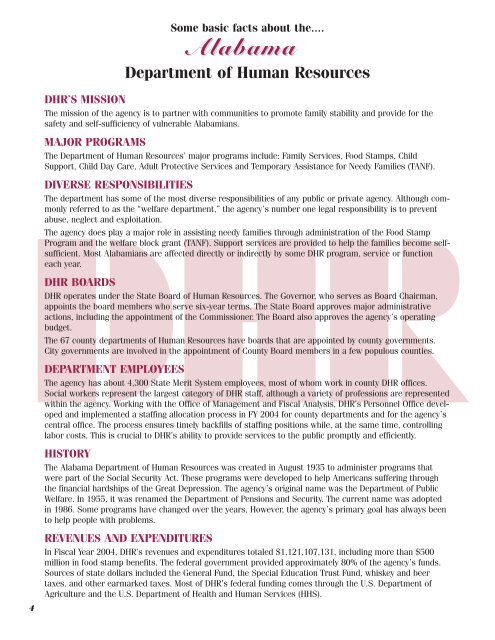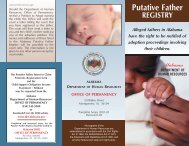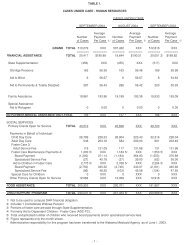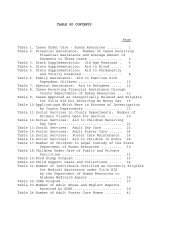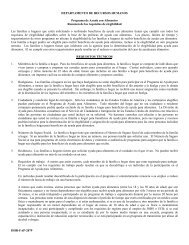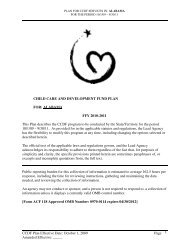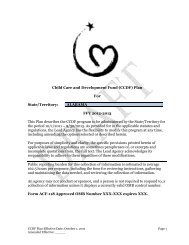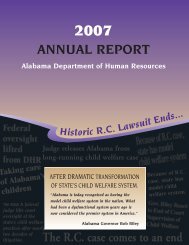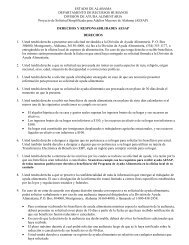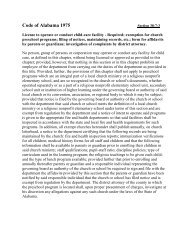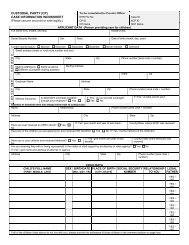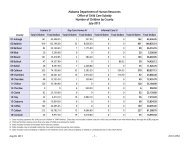04 ANNUAL REPORT 2 - Alabama Department of Human Resources
04 ANNUAL REPORT 2 - Alabama Department of Human Resources
04 ANNUAL REPORT 2 - Alabama Department of Human Resources
- No tags were found...
Create successful ePaper yourself
Turn your PDF publications into a flip-book with our unique Google optimized e-Paper software.
DIVERSE RESPONSIBILITIESThe department has some <strong>of</strong> the most diverse responsibilities <strong>of</strong> any public or private agency. Although commonlyreferred to as the “welfare department,” the agency’s number one legal responsibility is to preventabuse, neglect and exploitation.DHR4Some basic facts about the....<strong>Alabama</strong><strong>Department</strong> <strong>of</strong> <strong>Human</strong> <strong>Resources</strong>DHR’S MISSIONThe mission <strong>of</strong> the agency is to partner with communities to promote family stability and provide for thesafety and self-sufficiency <strong>of</strong> vulnerable Alabamians.MAJOR PROGRAMSThe <strong>Department</strong> <strong>of</strong> <strong>Human</strong> <strong>Resources</strong>’ major programs include: Family Services, Food Stamps, ChildSupport, Child Day Care, Adult Protective Services and Temporary Assistance for Needy Families (TANF).The agency does play a major role in assisting needy families through administration <strong>of</strong> the Food StampProgram and the welfare block grant (TANF). Support services are provided to help the families become selfsufficient.Most Alabamians are affected directly or indirectly by some DHR program, service or functioneach year.DHR BOARDSDHR operates under the State Board <strong>of</strong> <strong>Human</strong> <strong>Resources</strong>. The Governor, who serves as Board Chairman,appoints the board members who serve six-year terms. The State Board approves major administrativeactions, including the appointment <strong>of</strong> the Commissioner. The Board also approves the agency’s operatingbudget.The 67 county departments <strong>of</strong> <strong>Human</strong> <strong>Resources</strong> have boards that are appointed by county governments.City governments are involved in the appointment <strong>of</strong> County Board members in a few populous counties.DEPARTMENT EMPLOYEESThe agency has about 4,300 State Merit System employees, most <strong>of</strong> whom work in county DHR <strong>of</strong>fices.Social workers represent the largest category <strong>of</strong> DHR staff, although a variety <strong>of</strong> pr<strong>of</strong>essions are representedwithin the agency. Working with the Office <strong>of</strong> Management and Fiscal Analysis, DHR’s Personnel Office developedand implemented a staffing allocation process in FY 20<strong>04</strong> for county departments and for the agency’scentral <strong>of</strong>fice. The process ensures timely backfills <strong>of</strong> staffing positions while, at the same time, controllinglabor costs. This is crucial to DHR’s ability to provide services to the public promptly and efficiently.HISTORYThe <strong>Alabama</strong> <strong>Department</strong> <strong>of</strong> <strong>Human</strong> <strong>Resources</strong> was created in August 1935 to administer programs thatwere part <strong>of</strong> the Social Security Act. These programs were developed to help Americans suffering throughthe financial hardships <strong>of</strong> the Great Depression. The agency’s original name was the <strong>Department</strong> <strong>of</strong> PublicWelfare. In 1955, it was renamed the <strong>Department</strong> <strong>of</strong> Pensions and Security. The current name was adoptedin 1986. Some programs have changed over the years. However, the agency’s primary goal has always beento help people with problems.REVENUES AND EXPENDITURESIn Fiscal Year 20<strong>04</strong>, DHR’s revenues and expenditures totaled $1,121,107,131, including more than $500million in food stamp benefits. The federal government provided approximately 80% <strong>of</strong> the agency’s funds.Sources <strong>of</strong> state dollars included the General Fund, the Special Education Trust Fund, whiskey and beertaxes, and other earmarked taxes. Most <strong>of</strong> DHR’s federal funding comes through the U.S. <strong>Department</strong> <strong>of</strong>Agriculture and the U.S. <strong>Department</strong> <strong>of</strong> Health and <strong>Human</strong> Services (HHS).


